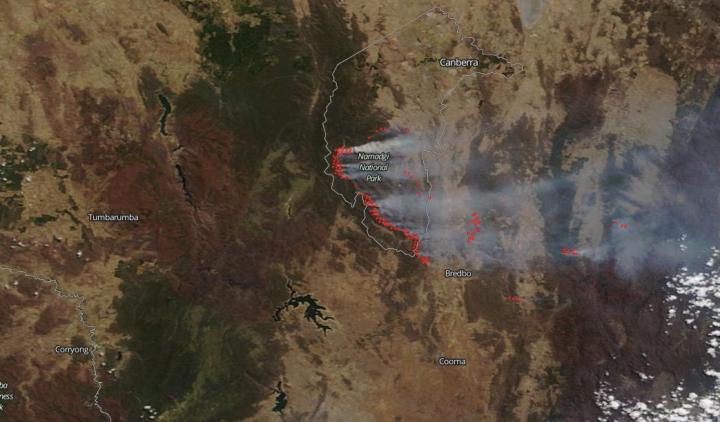
Credit: NASA
NASA’s Terra satellite saw yet another fire, known as the Orroral Valley Fire, break out in the Canberra region of Australia, specifically in and around the ?Namadgi National Park. In one week, these fires have consumed 62,988 hectares (155,646 acres) according to the Australian Capital Territory Emergency Services Agency as of Feb. 04, 2020 (2:30 am local Australian time). The Department of Defence in Australia has reported that a firefighting helicopter’s landing lights created the heat needed to spark the new fire. Since the area is tinder-dry, any bit of heat can provide the ignition for a new blaze. Below is a sliding image showing the true- and false-color images of the fire on Feb. 03, 2020 taken by the Terra satellite using the MODIS (Moderate Resolution Imaging Spectroradiometer) instrument. The dark red-brown color represents areas where the fires have burned the land.
NASA/NOAA’s Suomi NPP satellite also captured an image of the fires using their Day/Night band on the VIIRS ?(Visible Infrared Imaging Radiometer Suite) instrument. At night the fires can clearly be seen in this image from February 02, 2020. The fire line of the new blaze is extremely close to the city of Canberra, the capital of Australia. This area is under a State of Emergency until at least Sunday. Fire crews have, to date, been able to save all structures in the Australian Capital Territory.
NASA’s satellite instruments are often the first to detect wildfires burning in remote regions, and the locations of new fires are sent directly to land managers worldwide within hours of the satellite overpass. Together, NASA instruments detect actively burning fires, track the transport of smoke from fires, provide information for fire management, and map the extent of changes to ecosystems, based on the extent and severity of burn scars. NASA has a fleet of Earth-observing instruments, many of which contribute to our understanding of fire in the Earth system. Satellites in orbit around the poles provide observations of the entire planet several times per day, whereas satellites in a geostationary orbit provide coarse-resolution imagery of fires, smoke and clouds every five to 15 minutes. For more information visit: https:/
###
NASA’s Earth Observing System Data and Information System (EOSDIS) Worldview application provides the capability to interactively browse over 700 global, full-resolution satellite imagery layers and then download the underlying data. Many of the available imagery layers are updated within three hours of observation, essentially showing the entire Earth as it looks “right now.” Actively burning fires, detected by thermal bands, are shown as red points. Image Courtesy: NASA Worldview, Earth Observing System Data and Information System (EOSDIS). Caption: Lynn Jenner with information from William Straka III, Researcher from University of Wisconsin – Madison
Media Contact
Lynn Jenner
[email protected]
Original Source
https:/




